#1770s accessory
Text

Flower Hair Pin of Rubies, Diamonds, Sapphires, Topazes, and Emeralds, ca. 1770, French.
The British Museum.
#hair pin#accessory#1770s accessory#1770s#1770#french#1770s France#the British museum#diamonds#emeralds#sapphires#topazes#rubies
176 notes
·
View notes
Photo

Shoe
1760-1780
United Kingdom
The MET (Accession Number: 2009.300.4132)
#shoes#fashion history#historical fashion#1760s#1770s#1780s#georgian#rococo era#yellow#red#silk#united kingdom#fashion accessories#accessories#18th century#the met
302 notes
·
View notes
Text

Fan, 1775, France.
101 notes
·
View notes
Text

Pair of Wedgwood & Bentley agateware vases and covers. Made in the Etruria factory in Staffordshire, England, c. 1775.
#ceramics#design history#art history#pottery#fine art#pattern#decorative arts#ornament#homewares#home accessories#etruria#18th century#1770s#1775#vase#staffordshire pottery#the potteries#thomas bentley#josiah wedgwood#wedgwood#wedgwood and bentley
38 notes
·
View notes
Text
☆ talk to me
genre: fluff, angst (?), hurt/comfort
pairing: hyunjin x fem!reader
warnings: anxiety, cussing, conflict(?), crying blah blah
wc: 1770
t-note: i don't mean to make this a trend in my posts.....but i hate this fic lollsloslso TT first and foremost it's completely not my style of wirting, capitalization and all. but I found this unfinished with a completely different storyline and though hmmm this could be worth posting. ngl the quality of writing decreases as you read i feel like :3 the end is kind rushed (?), i couldn't figure out how to resolve it. please send me any feedback you have, as well as any requests!!
You both were at an award show. Hyunjin had on this gorgeous jet black suit, decked out in YSL accessories. His hair and makeup were done special that night, the stylist spending a few extra moments on each feature, and you honestly didn’t think you'd ever been more in love with him.
You were both sitting at a small table, while the rest of the boys were socializing with other idols. You both had just been given the green light on announcing your relationship, and Hyunjin wasted no time. Probably minutes after he received the call, he went straight to twitter to post a selfie of you two,
“my muse :)”
It’d been a few weeks since then, and soon enough came your first outing as an official couple, this award show. Your anxiety was at an all time high – though when was it not – and Hyunjin had been extra attentive and sweet to you all day, your happiness and comfort being most important to him.
But soon enough, you couldn’t stop the pit of guilt laced bile forming in your stomach. This was his special night, and here you were acting like a baby. I mean, really Y/n? You couldn’t have waited till-
“Baby?”
Suddenly your mind went silent for a second, and you realized your lover was trying to bring you back.
“Your eyes look cloudy baby what’s wrong? Do you need to step out for a minute?”
The pit starts to bubble extra hard.
Trying your best to put on a smile – although it comes out a little wobbly – “Of course not! I’m fine honey, just a little jittery waiting for the awards to be announced.”
It was a decent lie, but the execution was terrible and you both knew it.
“Babe…….” He questioned with his eyebrows raised skeptically.
“I’m fine Jinnie, I promise.”
His shoulders seemed to slack a little at that last part, though you could tell he was still on edge.
“Okay….I’m gonna go get us some water, don’t hesitate to come find me if anything at all happens. I mean it.” He stated sternly
“Cross my heart hope to die” You replied with a soft smile
And as heavy as your heart was, you still couldn’t help the way your eyes lingered on him as he walked away.
Wow…….He’s really yours.
Soon enough, it came time for the awards. Hyunjin was back by your side, the other boys in seats right next to him. His hand holding yours as the awards were announced.
“And Fan Favorite Boy Group of the Year goes to……… JYPE’s Stray Kids!!”
You couldn’t help but break into the widest grin you’d ever smiled as the boys stood up to go accept their award.
They were so talented, and they’d worked relentlessly so this win didn’t come as a surprise to you. They deserved it.
But what did come as a surprise to you, is when Hyunjin was about to walk away, he turned, leaned down, and planted a firm kiss right on your mouth. Now in the moment, you acted natural, kissing back and smiling then waving him off. But as soon as you were certain there were no cameras on you. Your smile dropped and your heart started racing.
Oh god, what would everyone think? They’re gonna talk about how unprofessional that was, and how the boys don’t deserve that award. Fuck this is all my fault, I shouldn’t have let him kiss me. I shouldn’t be here.
And unfortunately, right as you got up to excuse yourself, you didn’t notice the boys giving their individual thank you’s, and Hyunjin watching you run off with a look of hurt, worry, and betrayal plastered on his face.
To anyone else, your thoughts sounded completely irrational, but anxiety isn’t rational. And they took over your legs before you could think about it any further.
You don’t know how long you’ve been in the bathroom. It feels like it’s been a few minutes, but as you hear several rounds of applause, and soon enough rapid frantic knocking on the door, you know you’ve been in there far too long.
“Baby? Y/n? Babe please I know you’re in there?........Baby what happened?”
Fuck. You don’t know. You’re suddenly hit with a huge wave of humiliation and guilt. You know you couldn’t bear to look him in the eye. So with two quick swipes under your eyes, you swing the door open to see your Jinnie standing there, eyes glazed over, and out of breath – did he run here?
“Oh my god Y/n you had me worried fucking sick. What happened baby? You just ran off and I-”
“I’m fine Jinnie.”
You stated as firmly as you could in the moment. You felt a sharp pain in your chest as a look of hurt flashed across his face. You walked straight past him and beelined for the door you all came through. You just wanted to get home.
You soon heard harsh footsteps behind you, you could tell he was angry. Fuck.
You soon saw Leeknow waiting by the limo, and as you approached he shot you a look of concern and confusion, almost wordlessly asking you ‘are you okay?’. You mustered up a small smile of reassurance and climbed into the limo. This was going to be the longest ride of your life.
The whole way home, Hyunjin wouldn’t even look at you. Though you were trying to exactly grab his attention, his expression stayed the same the whole ride. Nonchalant. Too nonchalant for your liking. You know you deserved it but he looks so calm, you’d think nothing would’ve happened at all. And suddenly, the dull ache in your heart became a sharp, shooting pain.
You soon made it home, rushing out the car with a hasty goodbye and jogging to your door. Not even bothering to drop anything besides your shoes at the door, you rushed upstairs to the bathroom.
There’s no way Hyunjin would wanna talk to you right now…so what should you do? Maybe if you go to bed quick enough, you can sleep this all away, as if it was a bad dream. So that’s what you begin to do.
You strip out of your bordering uncomfortable dress and take the pins out of your hair, and get into the shower.
As you let the water run over you, you began to think.
How can I apologize for this? A regular “Sorry, I love you” can’t fix this. No, Hyunjin deserves better than that. He deserves better than me. God I hope he doesn’t break up with me, I don’t know what I’d do. He’s been really quiet, and I haven’t heard anything upstairs. Oh no what if he left? What if-
You hastily finish washing and all but leap out of the shower. After haphazardly drying off and throwing on a (his) t-shirt and underwear, you quickly pad downstairs.
As you descend the stairs you notice the silence that has taken over your home. It’s almost as if you're the only one home, and that scares you.
“Jinnie?” you almost whisper into the space.
Nothing.
Your heart starts to race and you feel like crying,
“Hyunjin?” you call as you roam throughout the downstairs.
He’s not here. You start to panic, looking frantically around for your phone, and just as the first tear falls and you start to bolt upstairs, you hear the door unlocking.
You spin around, and there he is. When did he change?
As he walks in with a bag and takes off his shoes, you freeze. You don’t know if you were ready for this conversation yet.
“Hi” He mumbles as he sets everything down on the counter.
“Where were you?” You force out, the weight in your chest making it hard to speak.
“I picked up some food for dinner, since neither of us-” He stops as he looks up at you, hair pulled back so he has a clear line of sight.
“What is it? Why are you crying?”
“I’m sorry.” you say with a wobbly voice
“I’m really really sorry I don’t know what my problem was earlier”
He stares at you for a long moment. Or maybe it was just for a second, you aren’t completely present.
“It’s okay baby. I was upset earlier but now I just wanna make sure you’re fed and figure out what’s wro-”
“No Jinnie I really mean it I don’t know what was wrong earlier but I swear to you it will never happen again” You said through heaving breaths- wait, heaving? When did you start crying?
“Hey hey hey baby it is fine. I promise you I’m not upset. Something was obviously wrong and I don’t blame you. At all.”
He swiftly moved toward you and wrapped you up in a hug.
“I know you get anxious sometimes, and it can cause miscommunication. But that’s why I need you to talk to me baby. Please. I know life can be a lot. Especially when my career is involved, but I need to know that you know you are my top priority always. And all I want is for you to feel happy and safe. So when I know that you don’t but you won’t let me help you, I start to feel a little helpless.”
He pauses and brings a hand to cradle the back of your head,
“Loving you is the easiest thing I’ve ever done, and I like to say it comes naturally. Like I was born to do it. But unfortunately, I can’t read your mind. So please. Help me help you baby. Let me help you”
He presses multiple kisses to the top of your head and that was the straw that broke the camel's back. You start to sob. Heavy, achy, cries but he can make out the few words you're saying.
“I love you Jinnie I’m sorry, I’ll always tell you what’s wrong I promise” You say punctuating with a long loud sniffle.
He squeezes you, “My sweet girl….I love you so much more”
He pulls away, “Let’s eat before it gets cold”
As he begins to walk and you follow, he dramatically sighs,
“I must say though…..I gave quite the speech…can’t believe you missed it baby”
As he looks up from the food, he sees your eyes tearing up once again,
“Oh my goodness baby, I was joking I’m sorry” He says as he pulls you in for another hug
He kisses your cheek and breathes out, “What will I do with you baby?”
thank u for reading :3
#taylorthawriter#skz fluff#skz imagines#stray kids fluff#stray kids angst#stray kids imagines#stray kids oneshots#skz x reader#hyunjin fluff#hyunjin angst#hyunjin imagines#hyunjin x reader#hyunjin stray kids
200 notes
·
View notes
Text
In 2014, American Girl tried re-branding the historical dolls under the BeForever name. They got all new outfits and shorter, re-vamped books. It fucked sucked and the line did not go well.
In 2017, they re-released Felicity with this, her third Met dress:

Historically speaking, that is very not bad. It actuall pretty closely resembles this ensemble from the Los Angeles County Museum of Art:
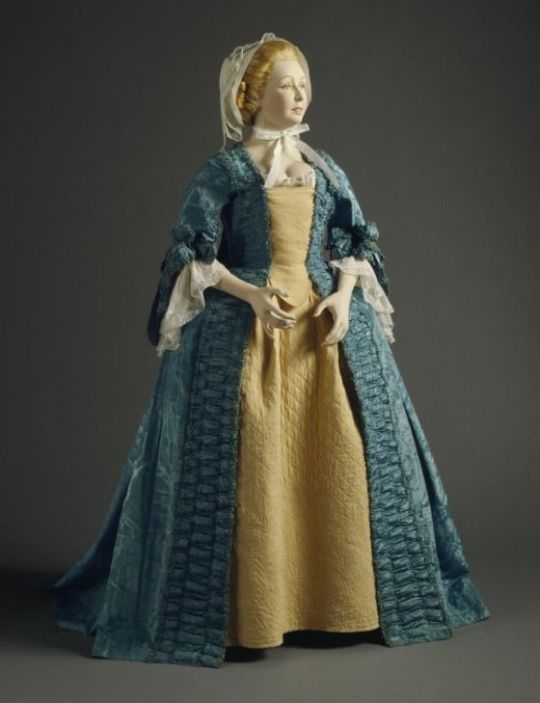
They’re clearly going for a polonaise dress and quilted petticoat, plus this time Felicity has a fichu! A super-important rococo-era fashion accessory that her original collection sorely lacked.
HOWEVER. when the dress is viewed from the back....

WOOF. Oh, that is unfortunate, both as a girly doll outfit and historically-speaking. The Robe à la Polonaise was made in imitation of the way Polish milkmaids would gather their skirts in back to hold the hem up and out of the mud while they worked. They were a part of the pastoral shift in fashion that happened in the 1770s and 1780s. Not only are they gathered in the back, they are ELEGANTLY and ELABORATELY draped over a petticoat:
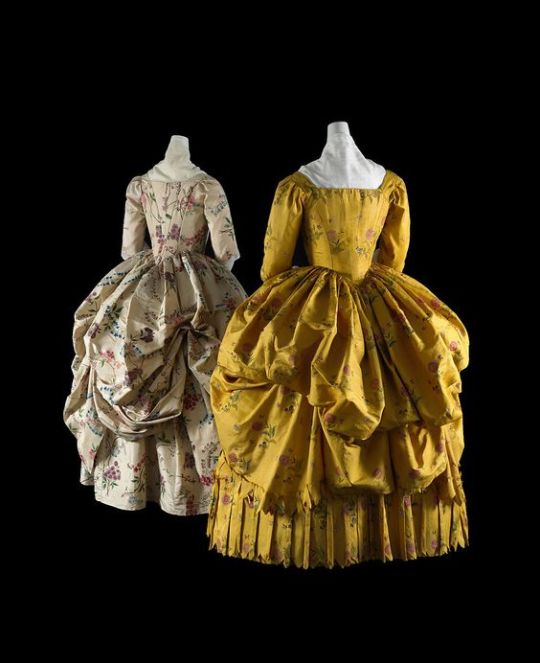
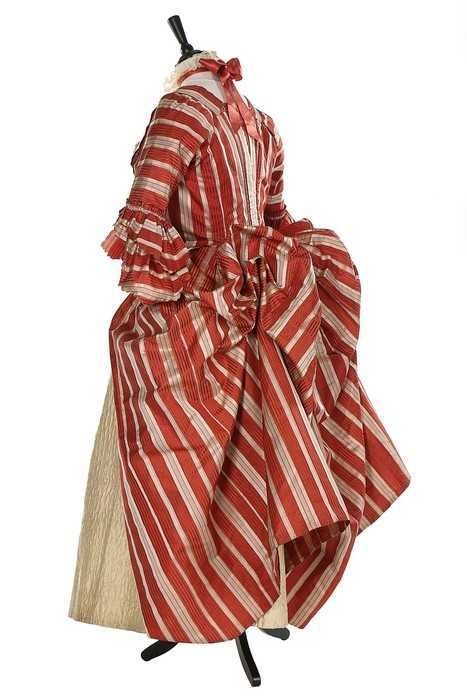
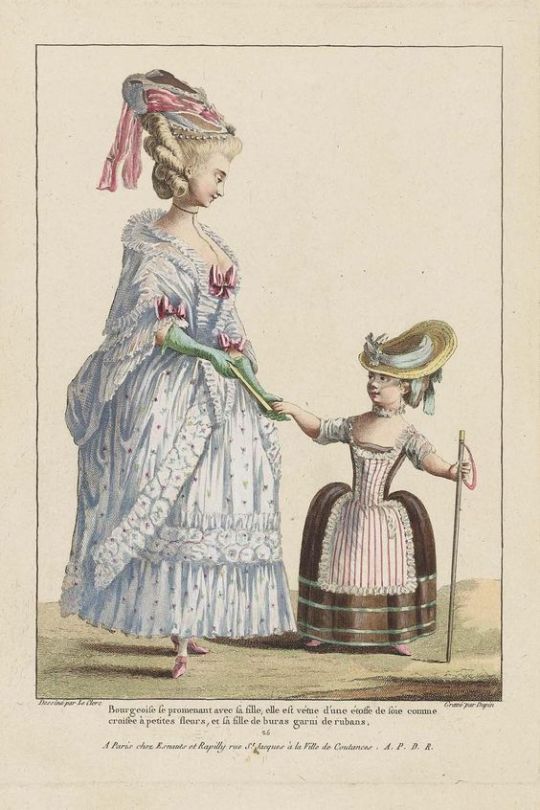
I know with mass-manufacturing dolls you have to take the elaborate-ness of a dress into consideration, but if you’re gonna cut corners on the fit of a polonaise, you’re gonna end up with a fucking mess. And they did end up with a fucking mess. Woof.
536 notes
·
View notes
Text
How to dress like you're from the Unknown (from OTGW):
Some good time periods to emulate include the 1890s, 1920s, 1980s, 1770s, 1810s, and 1620s
High waisted pants
Overalls and suspenders
Vests
Poofy sleeves
Swishy skirts
Earth tones
Grays and blacks
Have a signature odd piece of clothing or accessory
All of the vintage
Have fun and beware the Beast!
#over the garden wall#otgw#over the garden wall aesthetic#wirt#greg#jason funderburker#sarah#beatrice#the unknown
146 notes
·
View notes
Note
If you don't mind answering, what exactly makes something macaroni?
A Classical Dictionary of the Vulgar Tongue (1785) defines macaroni as follows:
An Italian paste made of flour and eggs; also a fop, which name arose from a club, called the maccaroni club, instituted by some of the most; dressy travelled gentlemen about town, who led the fashions, whence a man foppishly dressed, was supposed a member of that club, and by contraction stiled a maccaroni.
To put it simply a macaroni was a fop. That is a man who is too interested in fashion. Because interest in fashion was considered a frivolous female trait men who were "foppishly dressed" were often ridiculed for their gender nonconformity. The Natural History of a Macaroni describes the macaroni as follows:
There has within these few years past arrived from France and Italy a very strange animal, of the doubtful gender, in shape somewhat between a man and monkey, which has generated so much within that time, that they form at present no inconsiderable groupe in most of the public circles about town.
Its natural height is somewhat inferior to the ordinary size of men, though by the artificial height of their heels, they in general reach that standard; the face is quite effeminate, but sometimes distinguished by a little hair growing on it like a beard; the fore legs, or arms, are disproportionably long, the hind legs of a slender make.
Its dress is neither in the habit of a man or woman, but peculiar to itself, and varying with the day; at present it is principally discovered by an Indian flesh-coloured cloth, or silk, clasped all over with broad shining steel, and buttoned at the neck with a large black collar;
~ Walker’s Hibernian Magazine, July 1777, p458
The term macaroni really just means effeminate if someone or something was perceived as effeminate it was macaroni.
However as the term was predominantly used in the 1770s and 1780s it's associated with the fashion from those decades. So while there isn't strict rules dictating what is and isn't macaroni there are certainly some key aspects to the fashion that come up a lot in satire.
The Hair
Probably the most iconic aspect of macaroni fashion was the height of the hair. This was mocked in the satirical print What is this my son Tom. However in reality the hair was not worn that tall. Compare the caricature to Richard Cosway's self-portrait in which he is depicted wearing the fashionable style.


[Left: What is this my son Tom, print, c.1774, published by Sayer & Bennett, via The British Museum.
Right: Self-Portrait, Ivory, c.1770–75, by Richard Cosway, via The Met.]
The Suit
Menswear of the period consisted of the same basic elements; shirt, stockings, breeches, waistcoat and coat. At a time when English menswear was characterised by plain monochrome broadcloth macaroni fashion was disguised by the fabric, cut, colour and trimmings of the suit. Fashionable were the tightly cut French style suits known as habit à la française. Popular were brocaded and embroidered silks and velvets, sometimes further embellished with metallic sequins, simulated gemstones and raised metallic threads. In contrast to the black suit worn by many Englishmen, macaroni wore pastels, pea-green, pink, purple, red and deep orange.

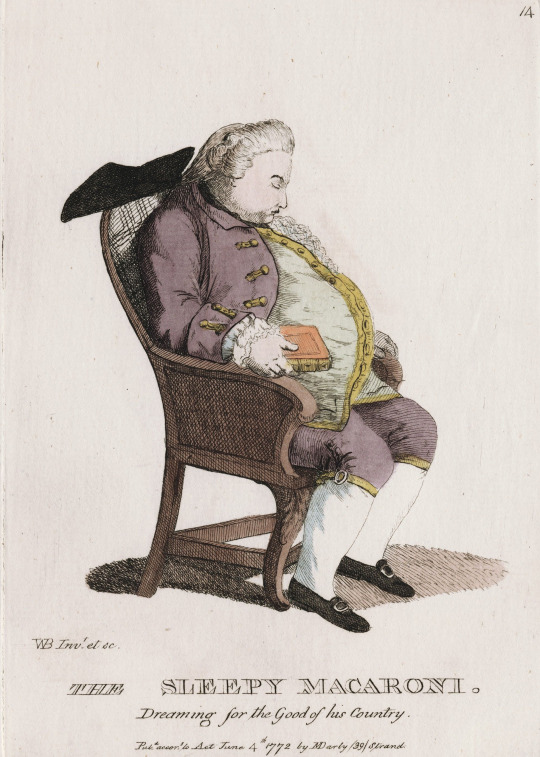
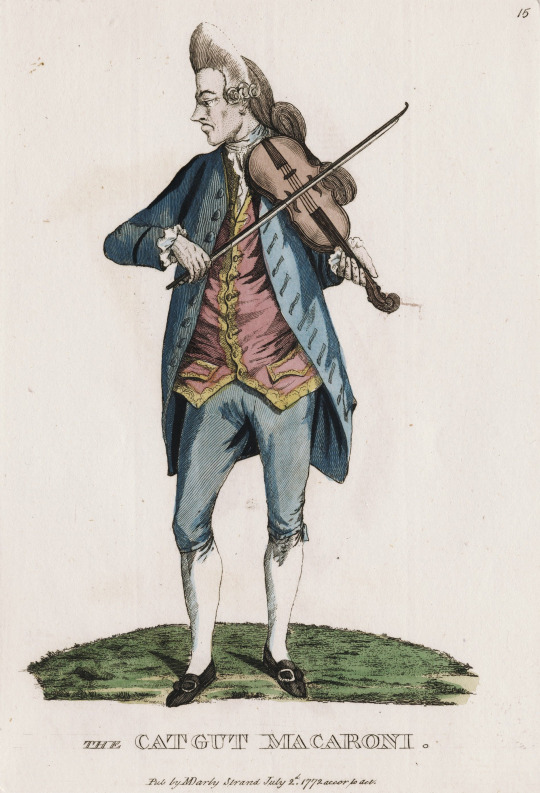
[Left: The Illiterate Macaroni, print, c.1772, by Matthew Darly, via Lewis Walpole Library.
Middle: The Sleepy Macaroni, print, c.1772, by Matthew Darly, via Lewis Walpole Library.
Right: The Catgut Macaroni, print, c.1772, by Matthew Darly, via Lewis Walpole Library.]
The Accessories
But a macaroni's ensemble was not done without accessories. Some examples of popular accessories include red heeled shoes, shoe strings, dress swords, canes, nosegays and muffs.

[Such Things Are, watercolour, c.1787, by Captain Mercer, via Lewis Walpole Library.]
If you want to learn more about macaroni I highly recommend reading Pretty Gentleman by Peter McNeil.
67 notes
·
View notes
Text
Abridged History of Qing Dynasty Han Women’s Fashion (part 5: Late Qianlong & Jiaqing eras)

(artwork from 1782)
Previous posts:
Late Ming & Shunzhi era
Kangxi era
Late Kangxi & Yongzheng eras
Qianlong era
The last two decades of the Qianlong era, the 1780s and 90s, formed one aesthetic continuity with the reign of Qianlong’s successor Jiaqing (1796-1820). This period was characterized by a turn to extreme formal simplicity and what I believe to be a revival of the tastes of the Ming-Qing transition.
We see sleeves of women’s robes, tight fitting and short to create a practical look in the previous era, become wider and longer. The folded cuff design was retained, though now more difficult to manage as the sleeves became wider. In the last post I discussed how the construction of dajin similar to Manchu men’s fashion became en vogue among Han women and replaced the earlier center front closing robes----this remained the same. We see some of the first instances of binding strips being used around the collar and the dajin, which would become a highly popular and elaborate craft later in the 19th century. Around this time, the binding strips used were usually thin and minimal, commonly of a black color. Plain cloth or bead tip buttons were popularized earlier in the Qianlong era, and metal clasp buttons (zimukou) became increasingly rare. The shape of the standing collar remained the same as that of previous centuries, soft, unstiffened and tall.
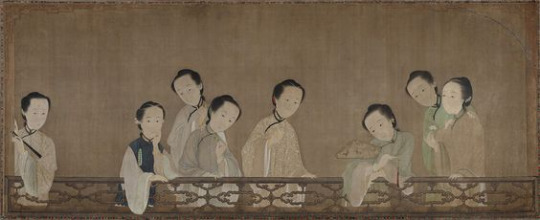
Artwork from 1796 showing a group of courtesans. You can see the black binding on some of their robes. A note about the dating of this artwork: while it’s quite a common reference image for Jiaqing era fashion, I wasn’t able to find an exact date until I read about it in the book Pictures for Pleasure and Use by James Cahill (spectacular book discussing the importance of vernacular and commercial art, highly recommend) and he said the date of creation was signed in the cyclical calendar and corresponds to either 1736 or 1796. He was inclined to 1736 because of “similar face shapes” or something to Yongzheng era artworks, but since he wasn’t a fashion historian he probably wasn’t aware that the fashions depicted here would not have been possible before the 1780s, so I think 1796 is instead the correct date.
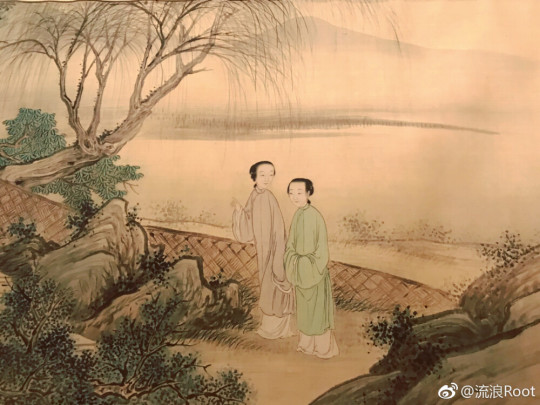
Late Qianlong/early Jiaqing era artwork, showing two austerely (and fashionably) dressed women.
The more radical departure from the previous era, however, was the complete eradication of ornament. Robes and skirts of this era were often entirely plain, with no brocaded patterns or embroidery of any kind. Gone were the roundel patterns, quatrefoil motifs on collar facings and decorative strips around skirts----only solid color blocks remained. Pastel colors like light pink, blue and green were among the most popular for robes besides bright blue and red, whereas skirts were white or black.

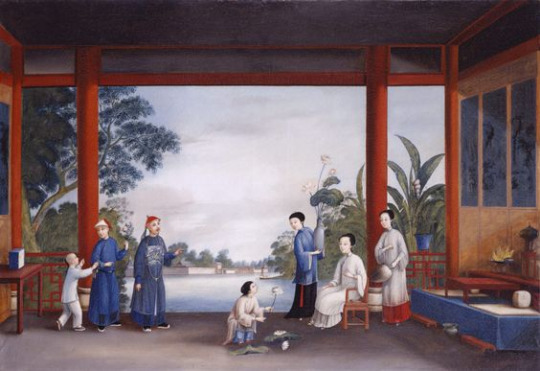
Late Qianlong/early Jiaqing era paintings of the Anglo-Chinese school showing the new style of plain garments.

Artwork from the era showing a woman in a light mustard robe with dusty pink cuffs, white skirt and red sash (sashes were still commonly worn).
The other significant changes happened in hairstyling. The 1780s did away with the iconic tall knots of the earlier Qianlong era, instead moving the mass and volume of hair toward the back. We see the re-emergence of the swallow tail. The front of the hair could be middle parted or completely pulled back. Flowers and other ornaments could be worn on the sides of the hairdo, behind the ears. The general shape of hairstyles stressed horizontality rather than verticality, as was the case before.
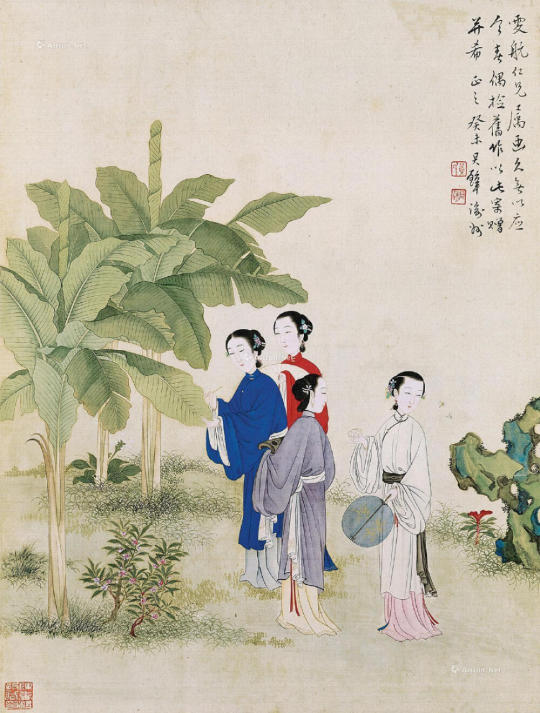
A 1943 copy of a turn of the 19th century original, showing the front and back of hairstyles.

Bust portrait showing the new hairstyle.
A unique hair accessory of the 1780s and 90s was a new iteration of the mo’e, which now had a sharply pointed triangular front and was worn high on the head instead of at the forehead. I think it became less common as the 19th century approached.
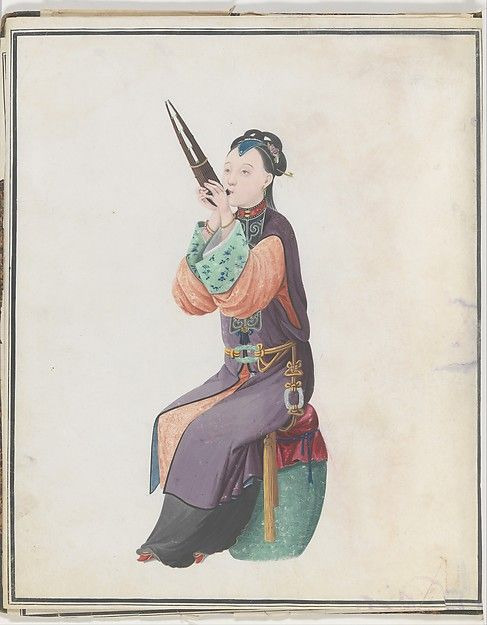
Export artwork showing a woman musician, likely 1770s or 80s as she is still wearing the ornamented, center front closing robes popular in previous decades.
Minimalism was not to last long, however, and soon decorative patterns began to reappear on robes, sleeve cuffs and skirts. Hairstyles began to gain volume and became more puffed, forming a sort of face framing crown. New styles of decorating skirts appeared, with binding going around the qunmen and the edge of each pleat, and embroidery on each individual pleat. The rectangular or circular patterned patch popular prior to the 1780s returned.

Early 19th century export painting at the Brighton Pavilion, maybe 1810s. We can see roundel patterns on the blue robe, embroidery on the cuffs and skirt, and the lady in red wears a pointed mo’e.

Presumably later Jiaqing era artwork, ca. 1810s, showing a group of women. Floral embroidery is present on the sleeve cuffs, the skirts are decorated.
#abridged history of qing dynasty han women's fashion#18th century#19th century#qianlong era#jiaqing era#qing dynasty#chinese fashion#fashion history#regency era
177 notes
·
View notes
Text
Khukurī (kukri) types and accessories
[a compilation of articles by Peter Dekker, Mandarin Mansion Antiques, 2020; text and photographs licensed under a Creative Commons Attribution 4.0 International License]
The Khukurī (खुकुरी )

A Nepalese khukurī, 1850s
The khukurī (खुकुरी) is the traditional utility and fighting knife of Nepal. It is strongly associated with the Ghurkas, a Nepalese soldier class. Khukurī are characterized by a forward curving blade that widens considerably before forming a fairly sharp point.
The knife goes by many names, but the best-established names and their romanization are khukurī (खुकुरी ) and the simpler khukri (खुक्रि), both appear in comparative and etymological dictionary of the Nepali language of 1931. [1] The simplified word kukri is in common use today, mainly among English speaking collectors.
18th century
The first few reliable images we get of early khukurī are two 18th century pieces, exhibiting striking similarities even though one is in a Chinese collection and the other was illustrated by an English expedition party.
First, an 18th-century khukurī that appears in the Palace Museum collection in Beijing.1 It was probably captured in battle or presented during the signing of a treaty during the Tibet-Ghurka conflicts of 1788-1792.
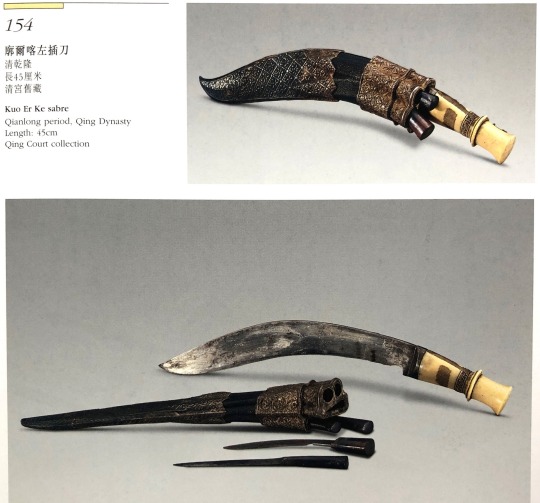
Khukurī in the Palace Museum collection, Beijing.
The relatively narrow handle with minimal flare in the pommel is also seen on Kirkpatrick's depiction of the khukurī, the first such illustration to appear in European sources.
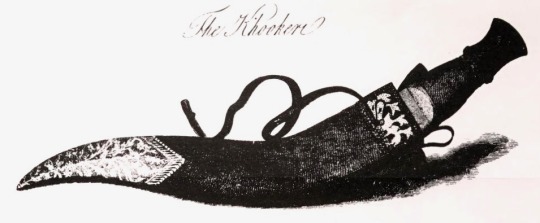
Early illustration of a khukurī. From Colonel Kirkpatrick's 1793 account of Nepal.
Another early piece, most likely the late 18th century, was obtained by Lord Egerton in 1855. It was published in his book Indian and Oriental Arms and Armour and is now in the Victoria & Albert Museum. V&A accession number: 3095(IS).

One of the Egerton khukurī
This piece has some early features like the shallow kauro (notch), and the overall form of hilt and blade. The workmanship looks Indian, and it may have been made by Indian craftsmen.
19th century
Some well known early 19th-century depictions of khukurī are in the Fraser Album. A few of them were actually made, commissioned by William Fraser (1784-1835), a late Mughal era British India civil servant in Delhi.

"Nepali soldiers" from the Fraser Album, published 1819.
Notable features seen on khukurī in these drawings are:
Long hilts with gently flaring pommels
Black enbroidered scabbards with small chape
A recurved shape to the scabbard
Types
Hanshee khukurī (हँसिया खुकुरी)
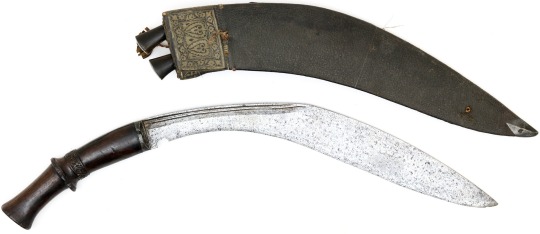
The hanshee khukurī or simply hanshee is an early type of khukurī that is characterized by having a long hilt and a rather long and relatively narrow blade with a strong curve. Other than most types of khukurī which double as fighting and utility knife, the hanshee appears to have been purely used as a weapon.
The word hanshee derives off the Nepali word hamsiyā (हँसिया) meaning "sickle". Another term used is lambendh, which supposedly means "long handle" containing the word lambe (लम्बे) meaning "long" in Nepali.
The hanshee appears to have been most popular in the late 18th and early 19th century and seems to have fallen out of use by the mid 19th century. Khukurī researcher V.K. Kunwor of Ghurka antiques writes about the hanshee: "These Kukri knives were very popular in the unification period of Nepal (1750-1770) and continued to be used in the Anglo-Nepal War 1814-1816 and up till the Indian Mutiny 1857, from whence it declined in popularity." He also writes that one of the defining features is a handle length of at least 13 cm.
Budhunē khukurī (बुधुने खुकुरी)

The fat-bellied budhunē khukri (bottom) compared to a more conventionally proportioned khukri (top)
Budhunē khukurī (बुधुने खुकुरी) is the name of a variation of khukri with a short, broad blade. It is a term that appears in the Comparative and etymological dictionary of the Nepali language of 1931.
Bhojpure subtype: The term Bhojpure turns up in John Powell's unfinished manuscript on the khukurī. Powell notes that it is a term later in use for the earlier budhunē type.
Well known khukurī researcher Viking Kunwor, writing in 2020 adds: "The Bhojpure (from a town (Bhojpur) in the mid hills of eastern Nepal) is one of several styles within the larger Budhume group (a term which is a based on a broad bellied fish spieces). The many tribes can be attributed to these weapons such as Limbus and Rais make only the deeper bladed Bhojpure, the Gurungs, Tamangs and Chhetris make the seerpat and the Newars are the artisans who are responsible for many of the finely carved wooden scabbards, intricate decoration and engraved blades."
Sirupātē khukurī (सिरुपाते खुकुरी)
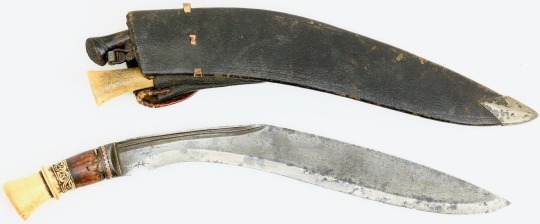
A sirupātē khukurī of the early 1800s.
Sirupātē (सिरुपाते) is a word commonly used to describe a long, slender version of a Nepalese khukurī.
The word sirupātē (सिरुपाते) appears in Ralph Lilley Turner’s A Comparative and Etymological Dictionary of the Nepali Language of 1931 and is described as: "सिरु-पाते siru-pāte,adj. Long and slender like a blade of siru"
Siru (सिरु) is the name of a local plant. Pātē (पाते) means "leaf". Turner gives the meaning for siru (सिरु) as the name of two varieties of grass or reed: (1) Imperata arundinacia (= khar-siru, used for thatching); (2) Imperata arundinacia var. latifolia. (Another possibility may be Hypoxis aurea which is called ban siru (बन सिरु) locally.)
Kothimora khukurī (कोथि मुहुड़ा खुकुरि)
Kothimora khukurī refers to a khukurī in an ornamental scabbard, usually with elaborately worked silver mounts but sometimes found in silver with parcel gilding or entirely golden mounts as well. 1
The term primarily applies to the scabbard, there may be a very mundane khukurī inside, although in some cases they were produced together and both of a higher than usual quality.
The word consits of kothi (कोथि), and muhura (मुहुड़ा). Kothi (कोथि) is the Nepali word for the silver chape on the scabbard of a khukurī. 2
Muhura means “face”. Colonel J.P. Cross states that the full wording would be “kothimora dap bha'eko khukurī”. This would literally translate to "silver chape face scabbard done khukurī", written in Nepali it is कोथिमुहुड़ा दाप् भएको खुकुरी.
John Powell, a pioneer in khukurī studies, distinguished three main types: The "Palace or Court kothimora", "regimental kothimora" and the "box kothimora". He also noted that many do not fall into these set categories, and those can just be referred to as kothimora khukurī.
Palace or Court kothimora: Usually with black leather covered scabbard with gold or silver scabbard mouth and endpieces. Each fitting worked in repousse or engraved, frequently with the National Coat of Arms of Nepal.
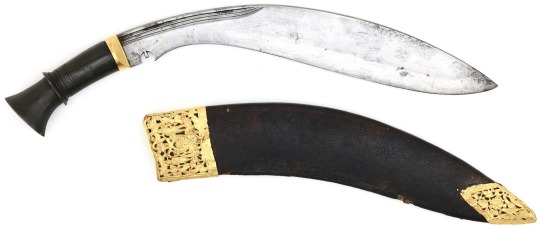
Palace or Court Kothimora khukurī
Regimental kothimora: The most commonly encountered type. These were primarily made for Ghurka soldiers. Powell describes that sometimes these were just regular fighting khukurī that were brought to the metal worker to fit the scabbard with a fancy dress, usually in repousse silver, as an honour permitted to men of valor.
As military weapons, they sometimes come with regimental insignia, but are more often encountered decorated with traditional local elements. Their wooden scabbards can be covered with leather or silk velvet.

A large kothimora khukurī.
According to Powell, in the British Indian army, regimental kothimoras were worn only by the Pipe Major (senior bagpiper) when on parade and senior NCO and ORs of the Officer's Mess. They were also presented to retiring Ghurka officers, or when an officer moved up rank.
Box kothimora: The main defining feature of this type is that the scabbard does not have separate leather or fabric pockets for karda and chakmak, it is all integrated in a single case, often clad in sheets of silver going around the circumference of the scabbard, and with mouthpiece and endpiece much like the regimental kothimora. These seem to have been primarily pieces that were presented to civilians.
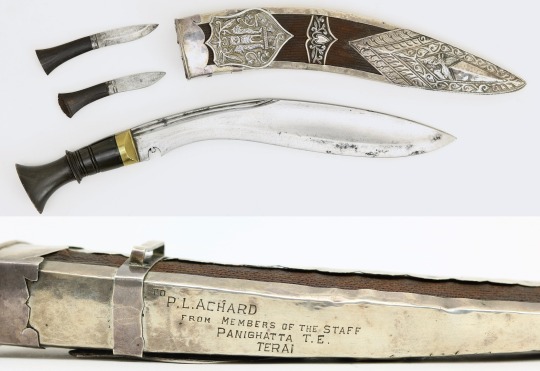
A box kothimora khukurī presented to wildlife conservationalist Peter L. Achard between 1947-1966.
Accessories

a "trousse khukurī" of the first half of the 20th century
Some items are often stored in the khukurī scabbard alongside the main knife.
Karda (कर्द)

Karda (कर्द) is the Nepali word for a small utility knife that was traditionally carried in the scabbard of a khukurī. The term comes from the Persian word kard (کرد), meaning "knife". A typical khukurī carries one, but some carry two of them in their scabbards.
Karda typically follow a similar construction as their parent khukurī, with wood, horn, bone, silver or ivory hilts and a metal bolster. The blades are usually more straight than khukurī.
Cakmak (चक्मक्)

Left: Five cakmak, right: Five karda. Notice the subtle differences at the pommel side and the absence of an edge bevel on the cakmak.
Cakmak (चक्मक्) is the Nepali word for a small knife-shaped fire and sharpening steel that was traditionally carried in the scabbard of a khukurī. [N.B. must be from Ottoman Turkish چاقماق / Turkish çakmak, "firestriker" (and later "lighter") < Common Turkic *čak- (“to strike”)]

The worked pommel ends of cakmak.
Cakmak typically follow a similar construction as their parent khukurī, with wood, horn, bone, silver or ivory hilts and a metal bolster. For easy recognition when sheathed, the back of the hilt is often grooved or ribbed, in contrast to the smoother backs of the typical karda.

The decoration helps differentiate them from the smooth-pommeled karda when sheathed.
The blades are usually shaped like a straight knife, but sometimes also shaped like a khukurī profile. Contrary to the karda, blades on cakmak are typically dull.
Khisā (खिसा)

Khisā (खिसा) is the Nepali word for a small purse that was traditionally carried in the scabbard of a khukurī.
The purse was usually used to hold tinder consisting of the bark of the sago palm, bamboo, or plantain. The tinder was called jhulo (झुलो), literally meaning "fiber".
— Peter Dekker, Mandarin Mansion
191 notes
·
View notes
Text
Swords
The sword, besides its function as a weapon, was an instrument worn as an accessory and symbolic. Thus the sword stood for leadership, power, justice, dignity and honour.

Lloyd's Patriotic Fund Sword and Belt of £100 Value to Jahleel Brenton Esq., Captain of H.M.S. Spartan, Presented in 1810 (x)
The sword is regarded as an emblem of military honour and is supposed to encourage the wearer to a righteous striving for honour and virtue. It is a symbol of freedom and strength. And so, especially in the 18th century, wealthy and high-born men carried swords to signify their status as gentlemen, such status being required of an officer in the Navy.

Captain Horatio Nelson (1758-1805), by John Francis Rigaud and an american officer, possibly Charles Goodwin Ridgely (1784-1848), by Gilbert Stuart, both with their swords (x) (x)
In battle, however, officers armed themselves often with short swords or cutlasses, which were suitable for close combat in the cramped conditions on the deck of a warship.

Naval Fighting Sword, 1770-1795 (x)
What we usually see on portraits were long swords, often with decorative hilts. These swords were dress swords, intended for display rather than combat. Sometimes officers were given valuable swords in recognition of bravery or outstanding service. These were then either taken on board or left at home and sold if necessary.

Officers sword, late 18th century (x)
When a naval officer was court-martialled, his sword was taken from him and placed on a table in the courtroom to show that his rank and standing had been put on hold. If he was acquitted, he received his sword back. If he was found guilty, the point of the sword was pointed at him and the verdict pronounced. This practice was maintained in Britain until 2004.
100 notes
·
View notes
Photo

Fan, 1775, France.
200 notes
·
View notes
Text
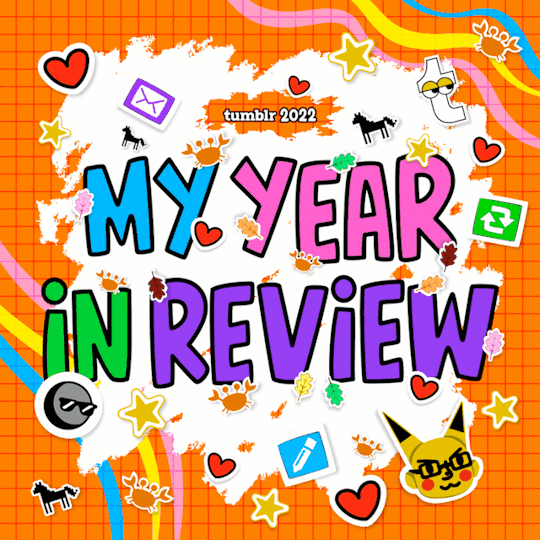
I posted 84 times in 2022
That's 8 more posts than 2021!
49 posts created (58%)
35 posts reblogged (42%)
I tagged 77 of my posts in 2022
Only 8% of my posts had no tags
#miraculous ladybug - 19 posts
#the locked tomb - 15 posts
#sketch - 14 posts
#tlt - 14 posts
#art - 10 posts
#ntn - 10 posts
#ml - 9 posts
#mlb - 9 posts
#nona the ninth spoilers - 8 posts
#nona the ninth - 8 posts
Longest Tag: 108 characters
#but i really like the cool tones on his skin because he’s normally so cool and level headed and calculating
My Top Posts in 2022:
#5
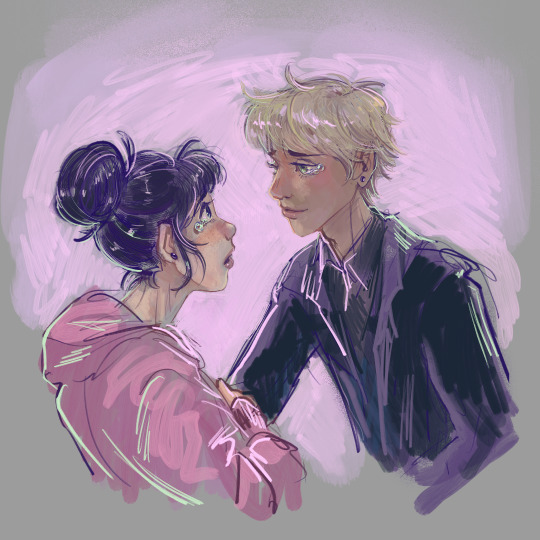
c’est moi, ma lady. 💜
based on the bakery enemies au comic by @buggachat - thank you for this wild ride!
5,299 notes - Posted August 31, 2022
#4
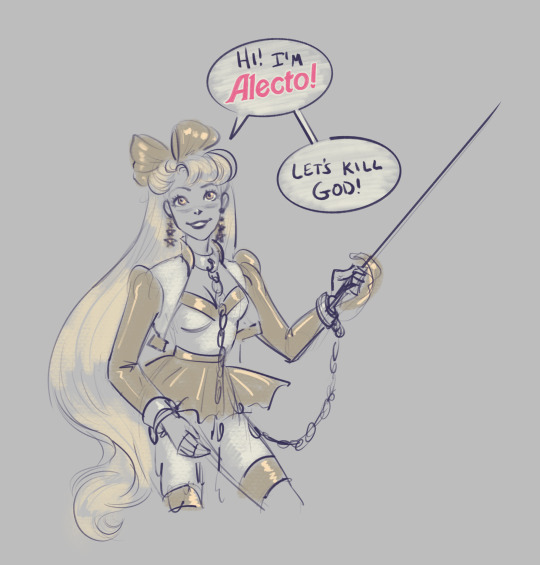
accessories sold separately
5,305 notes - Posted September 21, 2022
#3

“Tell me how to do it, and I’ll do it.”
been having a grand old time puzzling out Nona the Ninth and rereading the whole Locked Tomb series. here’s some warm and cool color variants:

See the full post
6,723 notes - Posted September 20, 2022
#2

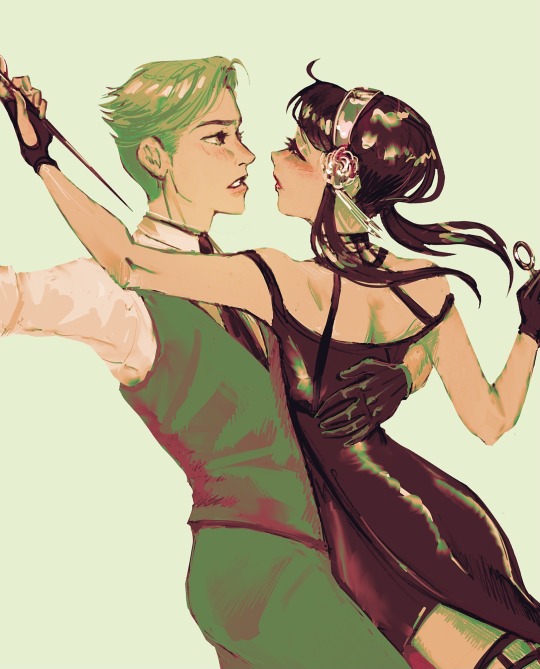
cleaned up this spy x family piece that’s been sitting on a back burner! gradient mapping really is a fun way to add some quick color 💋
11,644 notes - Posted August 1, 2022
My #1 post of 2022

thinkin bout 1970s/1770s crossover fashion 💕
17,853 notes - Posted March 11, 2022
Get your Tumblr 2022 Year in Review →
#tumblr2022#year in review#my 2022 tumblr year in review#your tumblr year in review#fascinating#y’all really loved that 1770’s meets 1970’s post
12 notes
·
View notes
Text
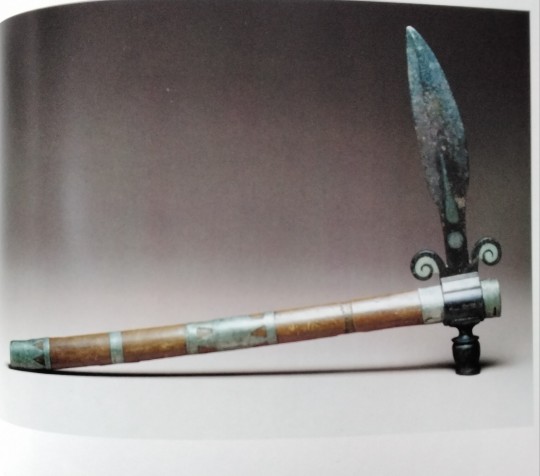
Cherokee Tsalagi pipe tomahawk, c.1770.
Region: South-eastern North America.
The pipe tomahawk, or peace axe, is attributed to the Cherokee Tsalagi people of the south-east – once the largest and most important tribe in the area. The tomahawk was made shortly before they were forced to leave their homelands in Georgia, North and South Carolina, Virginia, Kentucky and Tennessee. The pipe tomahawk is at once a symbol of both aggression and of conciliation, although they were used more as an accessory than a weapon. The name derives from the Algonquian word Tamalak or Tamalakan, meaning implement used for cutting. ‘Tomahawk’ is generally used to describe a lightweight axe, and this example doubles as an pipe. The various adornments used incorporated wood, metals and feathers, and Iroquois men traded furs for such tomahawks. They also became trading goods for European- Americans.
Such pipes had religious importance and were smoked at council meeting. Ornate tomahawk pipes were given as gifts to seal alliances between different groups and they gave status to their owners. Old photographs show prominent chiefs proudly carrying their tomahawk pipes in a ceremonial manner.
Source: ‘Folk Art’, Susann Linn-Williams, pp.162-63.
#Native American#traditional crafts#Cherokee Tsalagi tribe#peace axe#axe#pipe#tomahawk#Algonquian#chief#ceremonial
5 notes
·
View notes
Photo
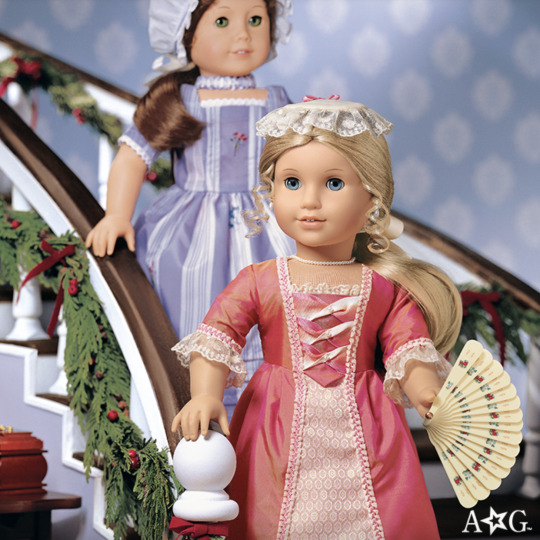
A doll version of Felicity’s best friend, Elizabeth, was released in 2005, along with her own book, Very Funny, Elizabeth! Immediately, there was controversy because in the classic books, Elizabeth had dark hair and eyes, and now, suddenly, the doll and book Elizabeth is blonde. The official reason was that they wanted to create more of a difference between Elizabeth and Felicity, but there was speculation that is was either done to match the actress in the movie, or that it was an act of Barbie-fication.
I’ve read some reviews of the dress lamenting the fact that it’s a very bright Barbie pink, but, the thing is.... pink was a very popular color in the 1770s:
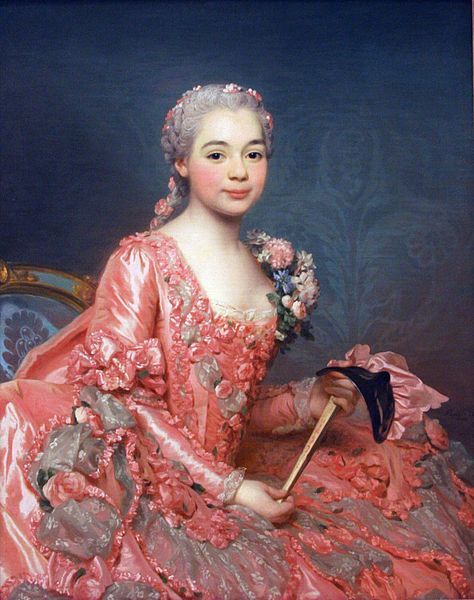
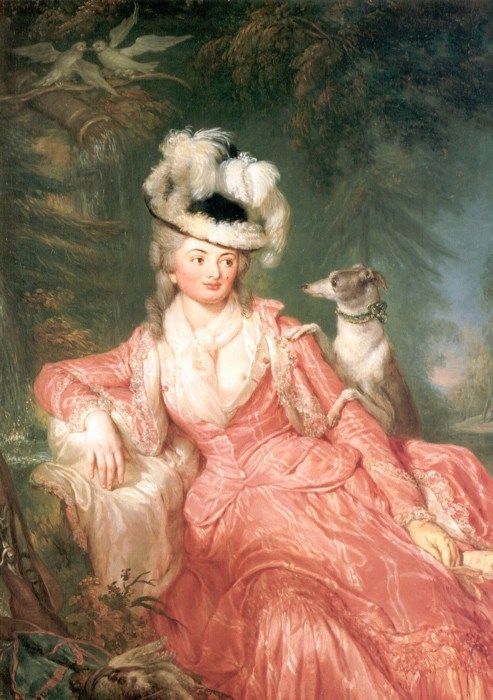
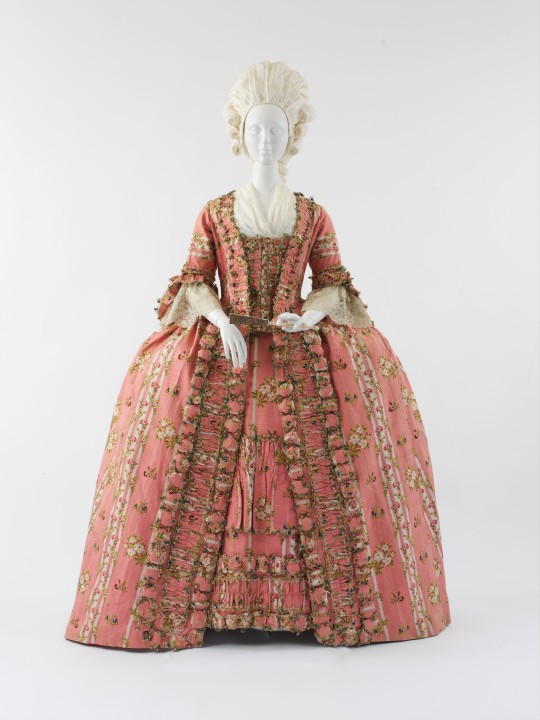

So I’m not gonna knock it for being the wrong color. What DOES bug me, however is the shot silk. It’s made by having warp fibers of one color and weft fibers of another, and it creates that shimmery, color-changing effect. In all my years of looking at historical fashion online, I haven’t found any extant examples of a rococo-era dress made of shot silk. HOWEVER, after much scouring of Pinterest, I DID manage to find a few examples of portraits where the subject appears to be wearing shot silk:
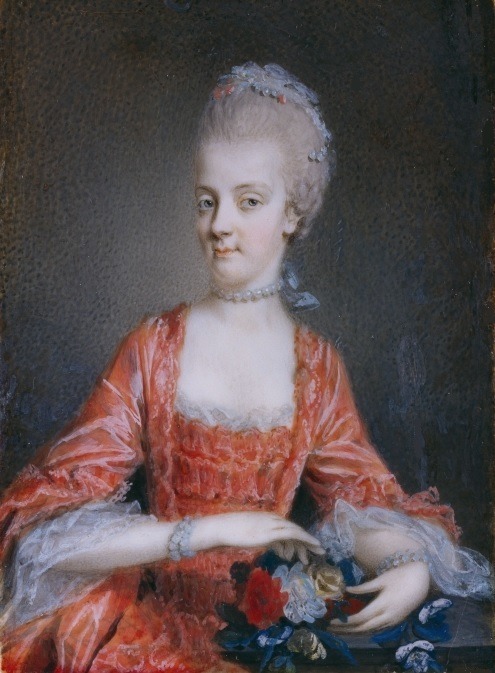
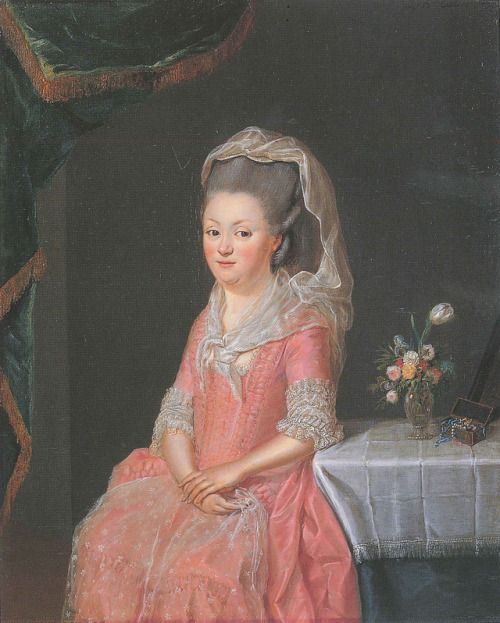

So I’m not sure about the accuracy. It wasn’t super common but it wasn’t unheard of.
In the original Felicity books, it is sort of hinted at that Elizabeth’s family is wealthier than Felicity’s, but in the movie and Very Funny, Elizabeth! it’s made pretty explicit. The story revolved around Annabelle (UGH, Annabelle was the worst!) getting engaged to an English nobleman. Elizabeth wears her pink dress to the engagement party. So again, it makes sense for Elizabeth to be wearing a fine dress with her fancy accessories:
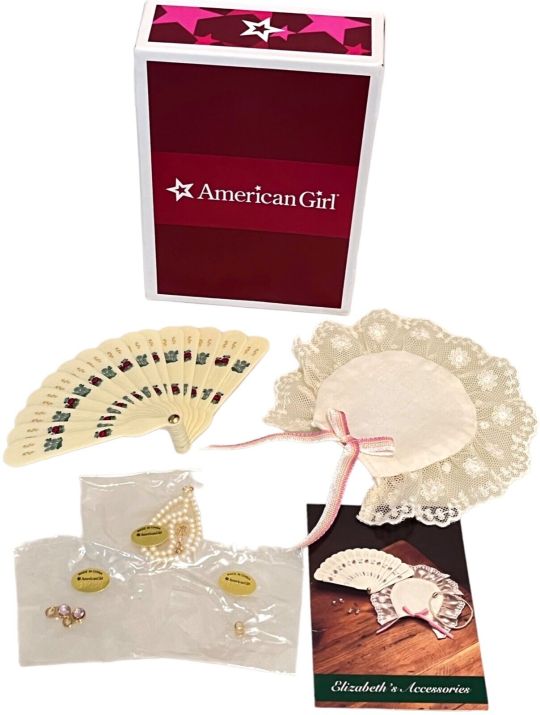
Giving a ten-year-old girl a pearl necklace and diamond earrings, the Coles had to have been loaded. Before the invention of cultured pearls, the only way to get pearls was for them to be formed naturally, and natural pearls are RARE!
The fan is a type of fan called a brisé fan, usually made out of ivory, horn, or shell, and they were more typical of the 19th century:

(ca. 1810-1820)
While they were more common later on, most 1770s fans were made of paper, which would probably make for a pretty flimsy toy, so I can see why they would have gone for the brisé style.
262 notes
·
View notes
Text
⛏Daily ASIC Price:
———— —— USDT —— U/T
🇭🇰HongKong NEW Bitmain🇭🇰
S19 82T 💰 927 - 11.3
S19 86T 💰 1015 - 11.8
S19 jpro 96T 💰 1296 - 13.5
S19 jpro 100T 💰 1400 - 14.0
S19 jpro 104T 💰 1487 - 14.3
S19 pro 96T 💰 1248 - 13.0
S19 pro 100T 💰 1350 - 13.5
S19 pro 104T 💰 1400 - 14.0
S19 JPRO+ 118T 💰 1652 - 14.0
S19 JPRO+ 122T 💰 1708 - 14.0
S19 Hyd 145T 💰 3625 - 25.0
S19 Hyd 151T 💰 3775 - 25.0
S19 Hyd 158T 💰 3950 - 25.0
S19 Pro+ Hyd 177T 💰 3292 - 18.6
S19 Pro+ Hyd 184T 💰 3478 - 18.9
S19 Pro+ Hyd 191T 💰 3667 - 19.2
S19 Pro+ Hyd 198T 💰 3821 - 19.3
S19 XP 134T 💰 3819 - 28.5
S19 XP 141T 💰 4230 - 30
T19 145T 💰 3190 - 22.0
L1 4900M 💰 2900
L7 8550M 💰 6500
L7 8800M 💰 6600
L7 9050M 💰 7550
L7 9050M 💰 6800 mix hashrate
KA3 166T 💰 7950
D9 1770G 💰 7200
K7 63.5T 💰 6400
K7 58T 💰 5500
Z15 420K 💰 2300
E9 Pro 3680M 💰 2950
🇭🇰HongKong NEW Whatsminer🇭🇰
M30S+ 104t 💰 1414 - 13.6
M30S+ 106t 💰 1442 - 13.6
M30S++ 100t 💰 1280 - 12.8
M30S++ 102t 💰 1275 - 12.5
M30S++ 106t 💰 1410 - 13.3
M30S++ 108t 💰 1469 - 13.6
M30S++ 110t 💰 1595 - 14.5
M50 110t 💰 1738 - 15.8
M50 112t 💰 1770 - 15.8
M50 114t 💰 1824 - 16
M50 118t 💰 1888 - 16
M50 120t 💰 1920 - 16
🇷🇺Moscow🇷🇺
Z15 420K 💰 2864
Z15 320K 💰 2064
Z15 200K 💰 1364
M30s+ 94T 💰 1316
M50 114T 💰 2210
M50 112T 💰 2175
🇨🇳ShenZhen NEW Whatsminer🇨🇳
M30S++ 98/100/102t 💰 / - 12.8
M30S++ 104/106t 💰 / - 13.2
M50 110t 💰 1650 - 15
M50 112t 💰 1680 - 15
M50 114t 💰 1710 - 15
M50 118t 💰 1888 - 16
M50 120t 💰 1920 - 16
M50S 128t 💰 2790 - 21.8
M50S 130t 💰 2834 - 21.8
M30S 96T 💰 - 13.4
M30S 84/86T 💰 - 12.8
🇨🇳ShenZhen NEW Avalon🇨🇳
A1166pro 78t 💰 780 - 10
A1246 90t 💰 900 - 10
A1246 87t 💰 1044 - 12
A1346 104t 💰 1456 - 14
A1346 107t 💰 1498 - 14
🇨🇳ShenZhen🇨🇳
V1mini 130M 💰 270
V1mini 300m 💰 620
V1mini 330M 💰 660
V1mini se 400M 💰 960
K1 MAX 💰 1300
BM-K3 70T 💰 3300
L1 4900M 💰 3300
D10+ 5000M 💰 3200
N3 25T 💰 2200
📍Used Miners: We mainly sell used miners such as S19 series, M30 series, Т17+, Т3+, S17 etc.
📍GPUs: We mainly sell high-end GPUs of well-known brands, such as hot-selling models of 2060-2080, 3080-3090, etc.
📍Accessories: We sell power supply,control board,hashboard and other accessories for mainstream miner models.
@HKCX_Simon
WhatsApp:+86 13652396240
2 notes
·
View notes